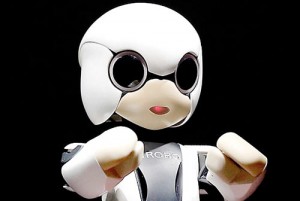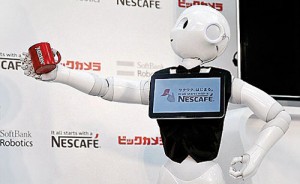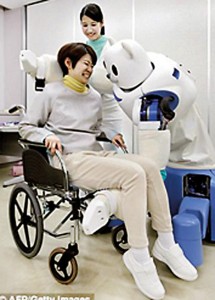Sunday Times 2
Robots may take our jobs and cause the global economy to crash
The race to create robots that look, act and work like humans could see unemployment soar, welfare costs increase and may eventually bring the global economy to its knees.

Economists used a simulated economy to create a model plotting a range of possible robot scenarios (Reuters)
That’s the dystopian scenario put forward in a report looking at how machines will revolutionise the workplace in the not-so-distant future.
Economists created a simple model to plot a range of possible robot scenarios to see how the machines could impact national income, capital and quality of service.
In their paper Robots are Us: Some Economics of Human Replacement, lead researcher Seth Benzell said: ‘Whether it’s bombing our enemies, steering our planes, fielding our calls, rubbing our backs, vacuuming our floors, driving our taxis, or beating us at Jeopardy, it’s hard to think of hitherto human tasks that smart machines can’t do or won’t soon do.’
With this in mind, Mr Benzell and his colleagues at the National Bureau of Economic Research asked whether ‘human replacement’ – the act of building better versions of ourselves – will deliver an economic utopia or leave us earning too little to buy the goods the robots are making?
Using a simulated economy, they found that the value of coders and developers will increase as the demand for smart machines rise.
As processes improve and technology advances the price to produce these machines will decline, which will deliver a ‘tech boom’. This in turn will raise the demand for new code. But over time, the stock of so-called ‘legacy code’ will grow because so many people are working on the projects, causing an abundance.
Plus this code will ultimately cause machines to become smarter and learn how to use the legacy code themselves.
This will cause demand for new code and, thus for high-tech workers, to drop and see such workers replaced by robot employees.
‘The resulting tech bust reflects past humans obsolescing current humans. These robots contain the stuff of humans – accumulated brain and saving power,’ said the paper.
The paper uses the example of Junior, the reigning World Computer Chess Champion. Junior can beat every current and, possibly, every future human on the planet.
The eventual decline in high-tech and, potentially, low-tech workers income will limit what young people can save and invest, continued the paper. This means less capital will be available for the future generations and production could actually fall over time, despite the fact machines are capable of producing goods more efficiently.
An alternative outcome of this is that high-skilled workers will move into low-skilled, lower paid positions, which will force these low-skilled workers into unemployment.
And once people are out of work, welfare costs will rise putting a greater strain on the economy. The authors even suggest people start saving for this eventuality.
‘The long run in such cases is no techno-utopia. Yes, code is abundant. But capital is dear. And yes, everyone is fully employed. But no one is earning very much,’ said Mr Bezell.
‘In short, when smart machines replace people, they eventually bite the hands of those that finance them.’
The study’s model firmly predicts three things – a long-run decline in the share of labour income, techbooms followed by tech-busts, and a growing dependency of current output on past software investment.
‘Our simple model illustrates the range of things that smart machines can do for us and to us,’ continued the paper. ‘Its central message is disturbing. Absent appropriate fiscal policy that redistributes from winners to losers, smart machines can mean long-term misery for all.’
© Daily Mail, London
| ARE THE PREDICTIONS ALREADY COMING TRUE? A recent report by management consulting firm Boston Consulting Group predicted by 2025 the number of ‘automatable’ tasks will rise to 25 per cent.  'The long run in such cases is no techno-utopia,' said the researchers. In short, when smart machines replace people, they eventually bite the hands of those that finance them.' A robot designed to replace a shop worker is pictured (Reuters)  The 'Robear' has a cub-like face but packs enough strength to transfer patients from a wheelchair (pictured) or a floor-level bed to a bath, for example (AFP) This will lead to robots replacing many human jobs – and is a trend that has already begun in Japan. Earlier this week Riken-SRK Collaboration Centre for Human-Interactive Robot Research in Nagoya, Japan unveiled its latest Robear. The ‘Robear’ has a cub-like face but has enough strength to transfer patients from a wheelchair or a floor-level bed to a bath. It weighs 309lb (140kg) with extending legs that stop the ‘bear’ from falling over and it moves slowly and smoothly thanks to advance actuators in its mechanical arms. And at the start of the month, Mitsubishi UFJ Financial Group said it will begin employing a humanoid called Nao in its branches from April, on a trial basis. And if the trial is successful, the robotic employees will be rolled out to more branches of the Japanese bank by 2020. From reception desk staff to security doormen and waiters, the Pengheng Space Capsules Hotel in Shenzhen, China, has built, rather than hired, new employees. Start-up costs and robot maintenance aside, staff bills are minimal and the hotel can pass these savings back to the customer as a night’s stay costs just £6.80 per night. |

